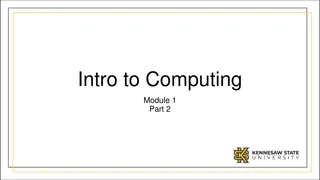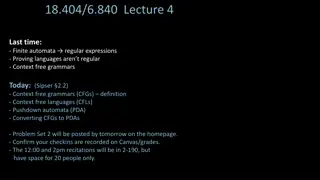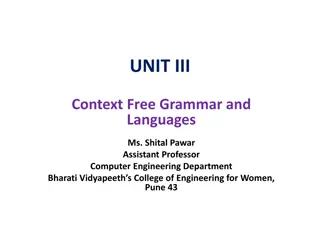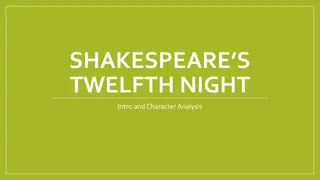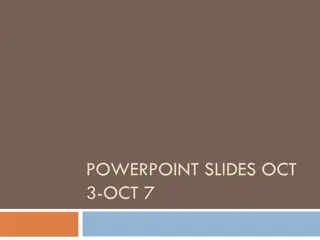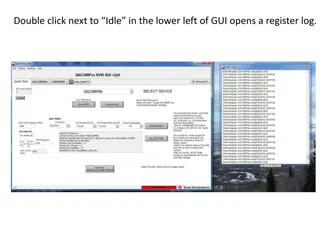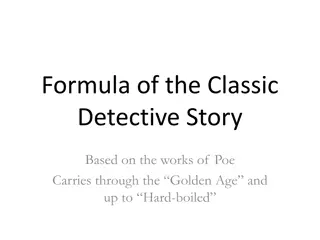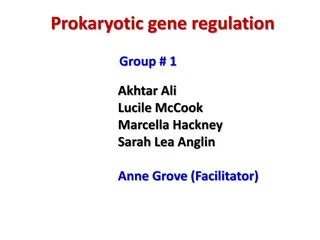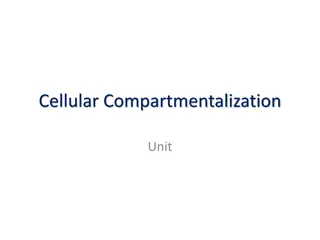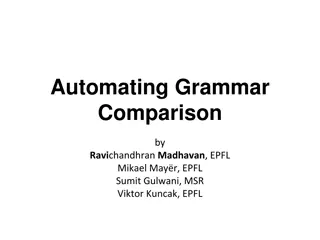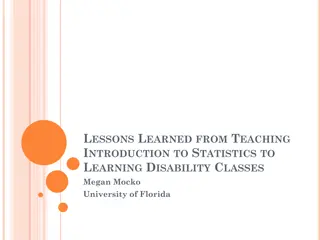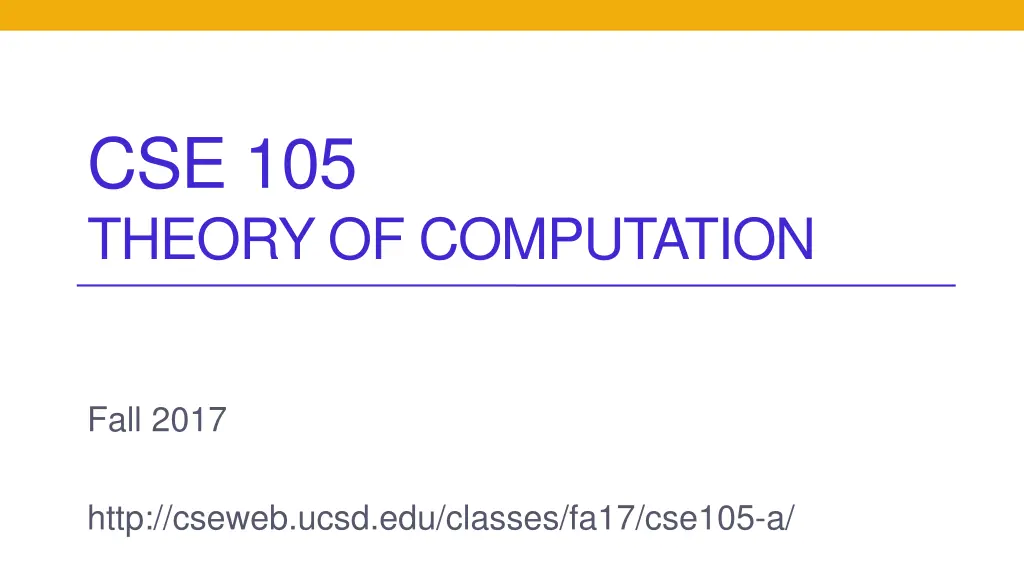
Theory of Computation: Pumping Lemma, Regularity Proofs & Nonregular Sets
Explore the key concepts in the theory of computation, such as applying the Pumping Lemma, proving nonregularity, and identifying context-free grammars. Delve into proof strategies for demonstrating a language is not regular. Discover examples and strategies for analyzing regular and nonregular sets.
Download Presentation

Please find below an Image/Link to download the presentation.
The content on the website is provided AS IS for your information and personal use only. It may not be sold, licensed, or shared on other websites without obtaining consent from the author. If you encounter any issues during the download, it is possible that the publisher has removed the file from their server.
You are allowed to download the files provided on this website for personal or commercial use, subject to the condition that they are used lawfully. All files are the property of their respective owners.
The content on the website is provided AS IS for your information and personal use only. It may not be sold, licensed, or shared on other websites without obtaining consent from the author.
E N D
Presentation Transcript
CSE 105 THEORY OF COMPUTATION Fall 2017 http://cseweb.ucsd.edu/classes/fa17/cse105-a/
Today's learning goals Sipser Ch 1.4, 2.1 Apply the Pumping Lemma in proofs of nonregularity Identify some nonregular sets Define context-free grammars Test if a specific string can be generated by a given context-free grammar
Pumping Lemma Sipser p. 78 Theorem 1.70 # states in DFA recognizing A Transition labels along loop
Proof strategy To prove that a language L is not regular Assume towards a contradiction that it is. Use Pumping Lemma to give p, a pumping length for L Show that p actually isn't a pumping length for L. Conclude that L is not regular.
Another example Claim: The set {anbman| m,n 0} is not regular. Proof: Consider the string s = You must pick s carefully: we want |s| p and s in L. Now we will demonstrate that "s cannot be pumped", thereby contradicting the assumption that p is a pumping length. Which choices of s cannot be used to complete the proof? A. s = apbp B. s = abpa C. s = apbpap D. s = apbap E. None of the above (all of these choices work).
Another example Claim: The set {anbman| m,n 0} is not regular. Proof: Consider the string s = You must pick s carefully: we want |s| p and s in L. Now we will prove a contradiction with the statement "s can be pumped" Consider an arbitrary choice of x,y,z such that s = xyz, |y|>0, |xy| p. This means that...What properties are guaranteed about x,y,z? Consider i= In this case, xyiz = , which is not in L, a contradiction with the Pumping Lemma applying to L and so L is not regular.
Regular sets: not the end of the story Many nice / simple / important sets are not regular Limitation of the finite-state automaton model Can't "count" Can only remember finitely far into the past Can't backtrack Must make decisions in "real-time" We know computers are more powerful than this model Which conditions should we relax?
The next model of computation Idea: allow some memory of unbounded size How? Generalization of regular expressions Context-free grammars Generalization for DFA Pushdown Automata
Birds' eye view All languages over Context-free languages over Regular languages over Finite languages over
Context-free grammar Sipser Def 2.2, page 102 (V, , R, S) Variables: finite set of (usually upper case) variables V Terminals: finite set of alphabet symbols Rules/Productions: finite set of allowed transformations R Start variable: origination of each derivation S
Context-free language Sipser p. 104 The language generated by a CFG (V, , R, S) is { w in * | Starting with the Start variable and applying one or more rules, can derive w on RHS} Notation: If G = (V, , R, S) the language generated by G is denoted L(G). Terminology: sequence of rule applications is derivation
An example? Consider the CFG ({S}, {0}, R, S) where R is the following set of rules S 0S S 0 Is this a well-formed definition? A. No: there's more than one rule B. No: the same LHS gets sent to two different strings. C. No: one of the string in the RHS has both variables and literals D. Yes. E. I don't know.
Context-free language Sipser p. 104 For CFG G = (V, , R, S), L(G) = { w in * | Starting with the Start variable and applying one or more rules, can derive w on RHS}. What is the language of the CFG ({S}, {0}, R, S) with R = {S 0S, S 0} ? A. {0} D. { , 0, 00, 000, } B. {0, 0S} C. {0, 00, 000, } E. I don't know.
Context-free language Sipser p. 104 What is the language of the CFG ({S}, {0,1}, R, S) with R = the set of rules S 0S S 1S S S 0S | 1S | A. L(0*1*) D. L ( (0*1*) )* B. L(0* U 1*) C. L( (0 U 1) *) E. I don't know.
Designing a CFG Can CFGs describe simple sets? Building a CFG to describe the language { abba } V = { S, T, V, W } = { a,b } R = { S aT S T bV V bW W a }
Designing a CFG Can CFGs describe simple sets? Building a CFG to describe the language { abba } V = = R = S = What's the set of terminals of this CFG? A. {a,b} B. V U S U C. {S, a, b} D. {a,b, } E. I don't know.
Designing a CFG Can CFGs describe simple sets? Building a CFG to describe the language { abba } ( { S, T, V, W } , { a,b } , { S aT , T bV , V bW , W a }, S ) OR ( { S } , { a,b } , { S abba } , S )
Is every regular language a CFL? Approach 1: start with an arbitrary DFA M, build a CFG that generates L(M). Approach 2: build CFGs for {a}, { }, {}; then show that the class of CFL is closed under the regular operations (union, concatenation, Kleene star).
Approach 1 Claim: Given any DFA M, there is a CFG whose language is L(M). Construction: Trace computation using variables to denote state Given M = (Q, , ,q0,F) a DFA, define the CFG V = { Si | qi is in Q } R = { Si aSj| (qi,a) = qj } U { Si | qi is in F} S = S0 prove correctness Then
Approach 2 If G1 = (V1, , R1, S1) and G2 = (V2, , R2, S2) are CFGs and G1 describes L1, G2 describes L2, how can we combine the grammars so we describe L1 U L2 ? A. G = (V1 U V2, , R1 U R2, S1 U S2) B. G = (V1 x V2, , R1 x R2, (S1, S2) ) C. We might not always be able to: the class of CFG describable languages might not be closed under union. D. I don't know.
Approach 2 If G1 = (V1, , R1, S1) and G2 = (V2, , R2, S2) are CFGs and G1 describes L1, G2 describes L2, how can we combine the grammars so we describe L1 U L2 ?
Designing a CFG We know this set is not regular! Building a CFG to describe the language { anbn| n 0 }
Designing a CFG Building a CFG to describe the language { anbn| n 0 } One approach: - what is shortest string in the language? - how do we go from shorter strings to longer ones?
Designing a CFG Building a CFG to describe the language { anbn| n 0 } V = { S } = { a,b } R = S Which rules would complete this CFG? A. S | ab B. S | aS | Sb C. S | aSb D. We need another variable other than S. E. I don't know.
Designing a CFG Also not a regular set Building a CFG to describe the language { 0n1m2n| n,m 0 } Hint: work from the outside in.
Designing a CFG Also not a regular set Building a CFG to describe the language { 0n1m2n| n,m 0 } Hint: work from the outside in. V = { S, T } = { 0,1,2 } R = { S 0S2 | T | S , T 1T | }









